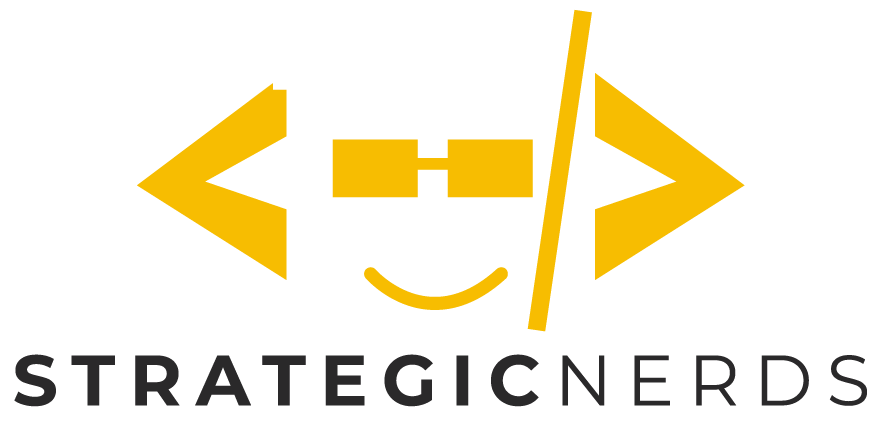Digital marketing for product-led growth (PLG) developer products

Product-led growth (PLG) enables you to focus your entire customer-facing SaaS business on a common goal: get people to sign up for your product. Once someone has signed up for your product, then a sales motion could kick in based on various qualifications you determine make the most sense for your business.
So, if signups are your golden metric, how do you drive more signups?
In this post, I'll describe my philosophy for developer growth and the digital marketing apparatus that undergirds the whole approach. In this post we will cover:
- The developer customer journey
- Content marketing
- Measuring content efficacy
- Website content
- Retargeting
- Paid acquisition
First: what is a sign up?
Obviously, you're interested in developers who sign up for your service. And while the initial goal is getting people to sign up, the ultimate goal is to get them to convert into a paid user.
But not all signups are created equal:
High quality signups from business email domains. These developers are actively investigating your product. How you handle the post-signup flow will depend on a few factors:
Are they from a Fortune 100 (or whatever makes sense for your business) brand? If so, you'll want to elevate these customers directly to your sales team for a high-touch nurture.
Are they actively using your product? If they're not in the "Fortune 100" cohort, elevate these customers to a customer care motion (slightly lighter touch sales motion).
Otherwise, use digital email nurture to spur these users into higher usage.
Low quality signups from gmail, hotmail, or similar email addresses. These signups typically do not convert to paid users at anywhere near the rate of high-quality signups. I typically put them into a digital email nurture. That said, you still may want to assign a junior sales rep to work these leads. Occasionally, you'll find a great customer hidden in this cohort.
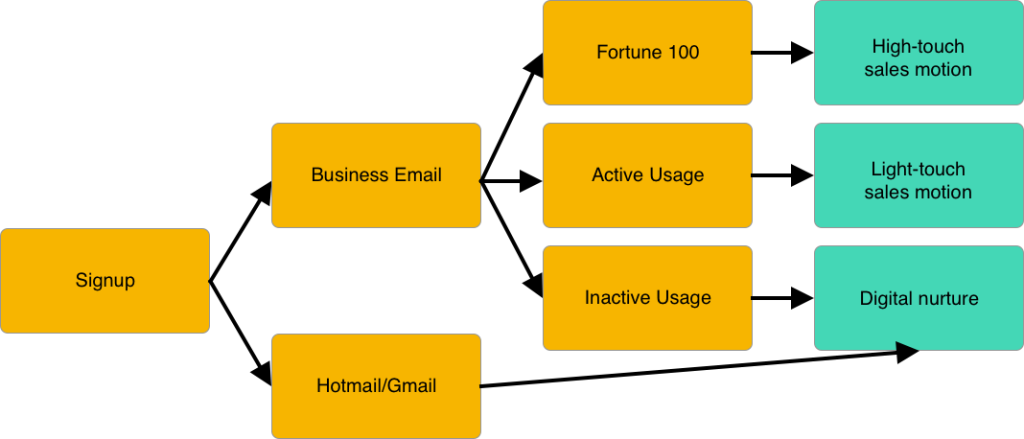
ACES
I frame marketing efforts across four dimensions: ACES (awareness, conversion, expansion, and systems). The plans and programs we put in place will differ depending on the customer segment, but ACES is a rough idea of the objectives, metrics, key results, tactics, and measurements we will need to put in place.
With this framework in mind, I like to lay out the following table and start filling in the gaps:
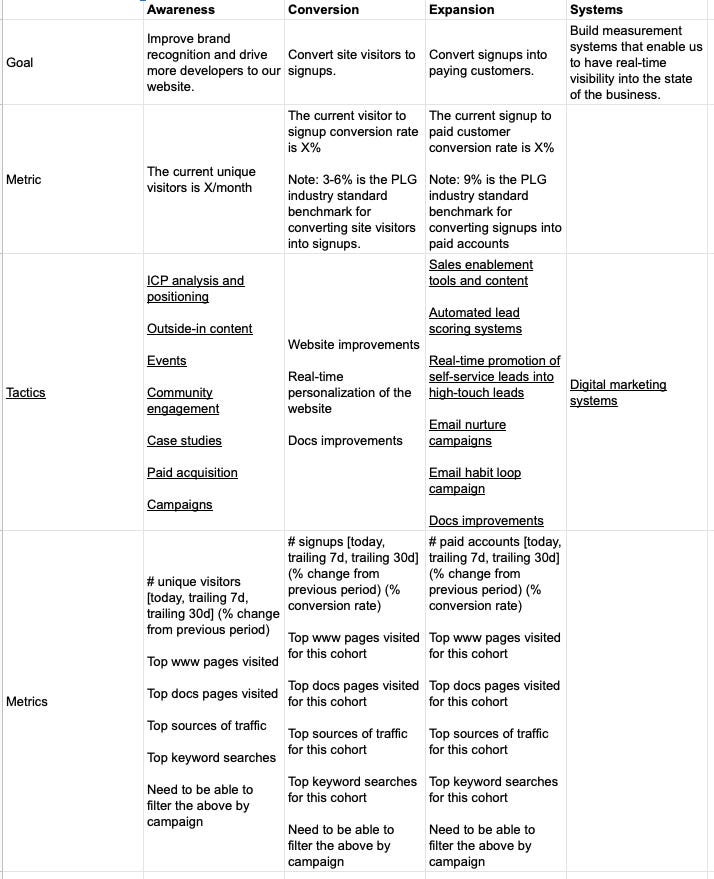
From here, it's time to turn our attention to our most pressing problems in the business. For some businesses, the issue is conversion. You're already generating a lot of buzz and site visitors, but you're not converting them. For many startups, the biggest issue is Awareness. You've built an amazing product, but no one knows you exist.
So, let's tackle Awareness first.
The developer customer journey
Not all "Awareness" is equal, though. Most marketers subdivide the developer customer journey into three types of users who visit your site:
Each phase of the customer journey will necessitate different types of content. Upper Funnel "lookie-loos" are probably interested in your Getting Started Guide and your website copy. But Bottom Funnel users are probably in an active consideration phase and will benefit from benchmarks or side-by-side comparisons.
Content is the spine of your growth engine
Organic traffic is comprised of customers who spot your content either being shared on social media, message boards, online communities, and so forth, or via search engines. You should invest in the content production discipline in your company.
Good content pays for every moment of time and dollar of resources you put into it. Good content seeks to teach developers something new. As I talked about in my post on how to write great launch blog posts, the most important approach you can take is to Help First. Write content that teaches developers something new about the profession, the history of the industry (or sub-industry), or the landscape of available tools.
Here's a handy mnemonic I use to describe the best kind of content for the developer audience:
- Outside-in content examines the kinds of questions developers are already asking and seeks to answer them.
- Inside-out content talks about the company's products and features and expects developers to care.
Notice the difference? Always think outside-in.
Within the funnel rubric described above, here are examples of effective content at each stage:
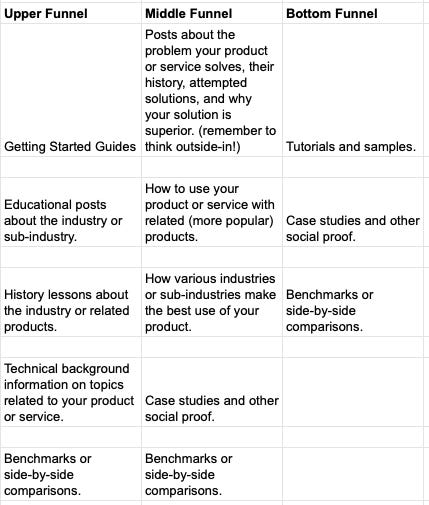
One last word: it's important to publish your content in multiple places, not just on your site and posts on social media. Syndicated content involves taking original content you've posted on your site and posting it to developer communities such as Dev.to, Code Mentor, and CodeProject. Read Stephanie Morillo's post on syndicating developer content.
Don't forget to attribute your content!
Measuring the efficacy of content
Some content will be more effective than others. As discussed above, Bottom Funnel users will likely be very interested in benchmarks or side-by-side comparison posts. These pieces of content will, therefore, skew much higher in statistical conversion since the user reading it already has high purchase or signup intent.
That doesn't mean that other content is less useful! And this is a significant danger in developer relations teams that are singularly metrics minded. They can lose sight of the main marketing goal in a PLG motion: to attract a broad swath of users and drive signups.
Using MarTech tools, you can identify if a piece of content contributed to a signup. For example, a prospective user may view content written for Upper Funnel purposes but eventually return and sign up. You want to identify content that contributes to your signups and you may need to spend a little money on tools that give you attribution data (such as Heap Analytics or Amplitude).
When thinking about content, I always recall a phrase from my time as a screenwriter: "Kill your darlings." Don't get so enamored with your content ideas that you're not willing to examine data and decide it's not working for you.
Experiment boldly, but move on quickly from mistakes.
One of my favorite failures was when I tried to create an online conference for "Public Data Sets", an industry topic tangentially related to our database product. You would think it was an example of outside-in thinking, but in reality it was very inside-out. It ostensibly involved building content for the community with nary a mention of our product or service, but it was hosted on our website in our YouTube channel, and the effort we had to expend to drive awareness of our community only served to distract from our awareness building elsewhere.
Website content
I spend a lot of time talking about blog posts and other technical content, but don't forget important components of your website that will optimize for conversion:
- A clean homepage that describes who you are (your positioning), your problem space, social proof, top-level features, and the types of problems your solution is for.
- Product detail pages that offer lots of, well, detail! Don't try and skimp. Give developers what they crave: knowledge and information! Let your homepage be the pithy destination. Let your product detail pages do the heavy lifting. And, please, only one product per product detail page!
- Pricing page that is separate and is clear on how much your solution costs, when someone has to start paying, and whether there is any Freemium or Trial version available. PLG products are self-service. Don't try and hide pricing. (a good practice for PLG is a Freemium offering, even more so than a time-limited Trial!)
- A simple signup page. This is the one and only way to sign up for your product. Funnel all traffic here, and then spend a lot of time optimizing it.
- Solutions pages that examine how industry verticals and horizontal applications would use your product or service. I once worked for a company that was adamantly opposed to solutions pages. Their growth (or lack thereof) spoke for itself. I explain why solutions pages matter below.
- Links to Docs and your Blog in your top nav.
One other thing, optimize your website for conversion. If you're opting for a Product-Led Growth motion, your conversion is "Try Now". Maybe (maybe???) you will offer a "Talk to Sales" type of conversion as well. But, honestly, if you're bought in to PLG, you want to focus on the Try Now and sometime later, when you're big enough, you can layer in options to talk to a customer care person.
I talk to my teams a lot about the concept of "cognitive load". When you present users with choices, it is paradoxically harmful. Give users as few options as possible. Focus their energy on signing up for your product. This is why I'm so opposed to product pages that offer too many choices.
Raising the efficacy of content with retargeting
Retargeting is the magic pixie dust of developer growth. Think about this for a second: you've built a ton of very effective outside-in content. Because this content has been posted on social media sites and syndicated into developer communities, you're seeing healthy traffic for your content.
But more likely than not, your inbound traffic will read (or skim) the content you've posted, maybe poke around your site for things that pique their interest, and then bounce.
Retargeting enables you to serve ads to those users as they use social media properties like Twitter and Facebook. The key with retargeting is to make sure the ads are related to the content they viewed. So, for example, if they saw a Middle Funnel content piece about how to use your product or service in the IoT industry, the chances are high that they're interested in content related to the IoT industry.
This is why solution pages are so important! Solution pages give you a ton of really great signal with which to serve retargeting ads. Content oriented around industry verticals or horizontals do the same.
So, with retargeting, you would serve ads that showcase how your product or service is useful in the IoT industry (ideally with a short video case study from a valued customer), and direct click-throughs to a landing page that is a slimmed down version of your IoT industry solution page.
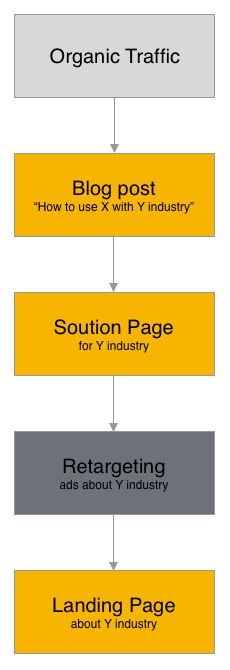
Paid acquisition
There's an old belief that "developers don't like ads." And this is true! In my experience, approximately 30% of developers use ad blockers and do their best to shield their privacy from interloping marketers. And of course, no one likes ads that are intrusive and detract from whatever experience we're enjoying online.
But developers do search for knowledge all the time. Whether it's a code snippet to get them unstuck on a problem or researching products or APIs to use in their application, developers spend an inordinate amount of time Googling for information.
Keyword search ads have been popular for a generation because they represent high-intent users. A user who searches for "IDE made for Rust developers" is probably looking for a development environment that carters to Rust developers, and if you happen to be selling one, that's precisely the kind of keyword for which you want to be number one on all search results.
Of course, you probably aren't lucky enough to organically rank #1 for all keywords of interest to you. Thus, you shouldn't be afraid to layer in paid ads as part of your mix.
I won't belabor the mechanics of keyword evaluation and ad creation here. There are plenty of resources and experts online for that. But I do want to offer a few tips:
- Always build dedicated landing pages for each of your ads. Streamline your messaging so it matches the ad creative, remove all site chrome, have one singular call to action (for PLG, it's "Try Now"), and please don't plop users onto your homepage expecting it to be self-explanatory. 22 years of digital marketing has taught us all a few things, and you're probably not going to be the person that reinvents the wheel here.
- Have realistic conversion expectations. Expect about 5% of people who see your ad to click-through to your site. Expect about 10% of people who see your site to convert into a signup. These are fairly industry standard, and developers aren't really any different (in the aggregate) than any other type of customer.
- Leverage your content. If you've done everything else in this post, you've built out a great content engine that addresses common questions about how your product or service helps various industries, horizontal problem spaces, and more. Be judicious in the number of links you add to your landing pages, but don't be afraid to link to that content.
My last thought on paid acquisition is that I have traditionally seen good performance out of LinkedIn ads, and pretty poor performance about Twitter ads. These are good areas for you to experiment with once you're up and running with landing pages and content for your search ads.
Summary
As indicated by this post, growth is a highly complex topic. It's also the most important topic in your entire business. Growth is oxygen. Growth today powers all the great things you want to do in the future.
Let me know if I can help you with your growth challenges.
